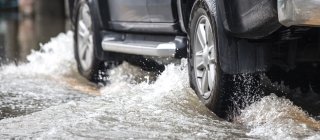How to Protect Your Health After Flooding

Protect your and your family's health from these common flood-related health hazards.
The recent flood waters in Vermont have receded, but health hazards caused by flooding remain. Mold may be growing in buildings, water wells and springs could be contaminated, and food affected by flooding might be unsafe to eat. In this article, we provide information on common flood-related health hazards to watch out for and give you some advice on how to protect your health.
Mold
Mold and mildew growing on surfaces is one of the biggest problems after a flood. If a home or building was unable to be dried out within 24 to 48 hours after a flood, it probably has mold growing in it. Not only does it look bad, exposure to mold can cause asthma attacks and allergic reactions. People with weakened immune systems or breathing problems can get serious lung infections from mold.
The Vermont Department of Health says that testing for mold is not necessary or recommended, as there is no way to determine if a building is safe or unsafe from mold. Instead, you should dry the building out and clean it as much as possible.
- Open all the doors and windows to let fresh air in.
- Use fans to circulate fresh air and dehumidifiers to remove moisture from the air.
- Clean items that do not absorb water (such as glass and plastic) with soap and water.
- Throw away any materials that absorb water, such as cushions and carpets.
- Drywall and insulation that has been touched by flood water must be removed and discarded.
Using a disinfectant to kill mold is not usually recommended, the Department of Health says, because dead mold can still cause health problems. Instead, mold must be removed completely by wiping surfaces with soap and water, and then vacuum surfaces with a HEPA filter vacuum cleaner. For areas that are hard to wipe clean, such as foundations with cracks and crevices, the Department of Health says you can use a disinfectant. Active ingredients like hydrogen peroxide or citric acid are safer than bleach.
When working in a building that has mold, be sure to wear protective clothing, including gloves, goggles, and an N-95 face mask. Before turning on a heating, ventilating, or air conditioning system, have it checked by a professional to prevent spreading mold throughout the building. Using a portable air cleaner with a HEPA filter can help reduce exposure to mold.
Drinking Water
If you have a private water system (such as a well or spring) that flood water may have reached, you should assume it is contaminated. Bacteria, microorganisms, and pollutants may have gotten into your water supply during the flood. The Vermont Department of Health says do not use your water system until it has been tested and you know it is safe.
Free drinking water test kits are available from the Vermont Department of Health for people whose private water systems were affected by flooding. To order a test kit, call the Department of Health’s testing lab at 802-338-4724. Test kits are also available at flood resource centers and local health offices.
You should check your well or spring for damage caused by flooding.
- Check the well casing for any bending or cracking, which could allow sediment and debris to enter the well and cause contamination.
- Inspect the well cap and seal to make sure they are securely fastened.
- Look at spring box tiles and other structural components to see if they are sealed.
If you find any damage, it should be repaired and the water disinfected before use. If heating fuel or chemicals may have been spilled near your well or spring, do not use the water and call the Vermont Department of Environmental Conservation at 802-828-1138 or 800-641-5005 to report the spill.
Food Safety
If flood waters reached your garden, do not eat any vegetables or fruit that came into contact with flood water. The Vermont Agency of Agriculture recommends waiting at least 30 days before replanting, to give the soil time to dry out and for any disease-causing bacteria or microorganisms to naturally die off.
Likewise, throw away any food inside your house that may have come in contact with flood water. Products in cardboard containers, like juice, milk, and baby formula, should be discarded. You should also not consume food in containers that might have leaked, such as those with screw caps or snap lids. Toss out any cans that are bulging, open, or dented.
If your power was off for four or more hours during the flood, throw out any perishable food (such as meat, milk, or leftovers) that was in your refrigerator, even if it was not touched by flood water. Frozen food that still has ice crystals can be refrozen or cooked. If frozen food thawed completely, it should be thrown away.
You can clean and sanitize utensils and other things that touch food by using a four-step process:
- Wash thoroughly with soap and clean water.
- Rinse with clean water.
- Immerse for one minute in a solution of one cup of bleach and five gallons of clean water.
- Allow to air dry.
Wooden cutting boards and baby bottle nipples and pacifiers should be thrown out, regardless. When it comes to food safety, the rule of thumb is “when in doubt, throw it out.”
Additional Resources
We hope this brief article is helpful in keeping your health safe during the flood recovery. For more information, here are some additional resources:
Vermont Department of Health Flood Safety page
CDC Food Safety After a Flood or Disaster
EPA Flood Cleanup to Protect Indoor Air
CDC Preventing Diarrheal Illness After a Disaster
CDC Preparing Infant Formula During an Emergency



